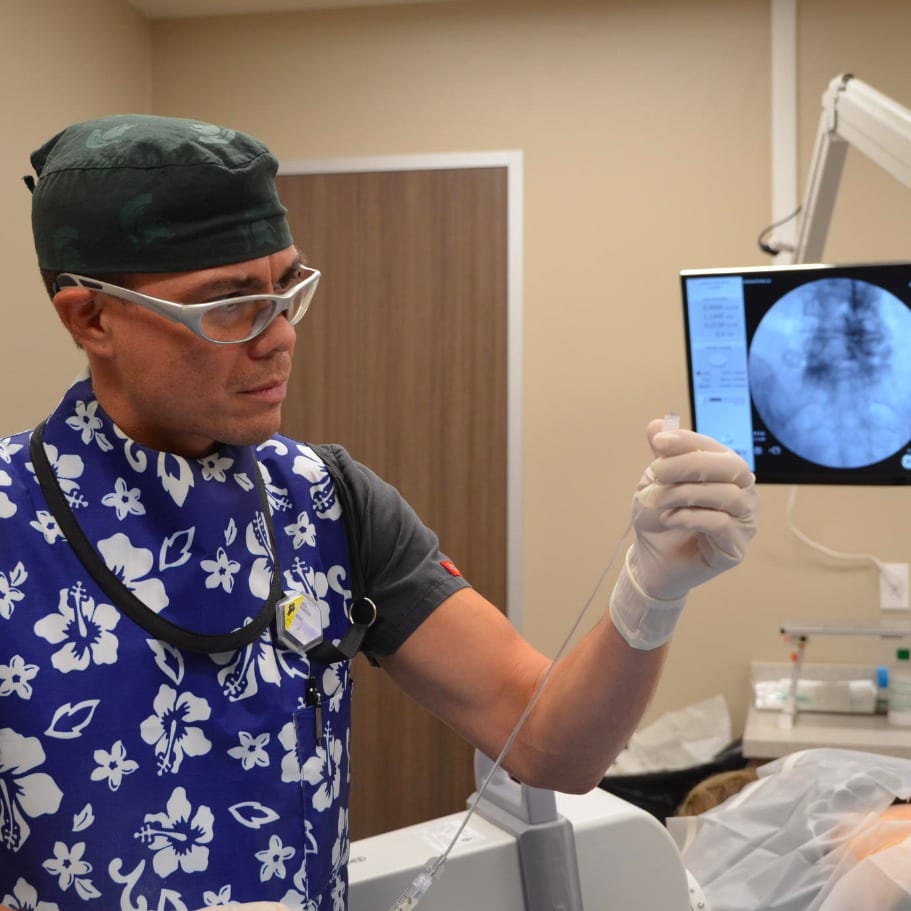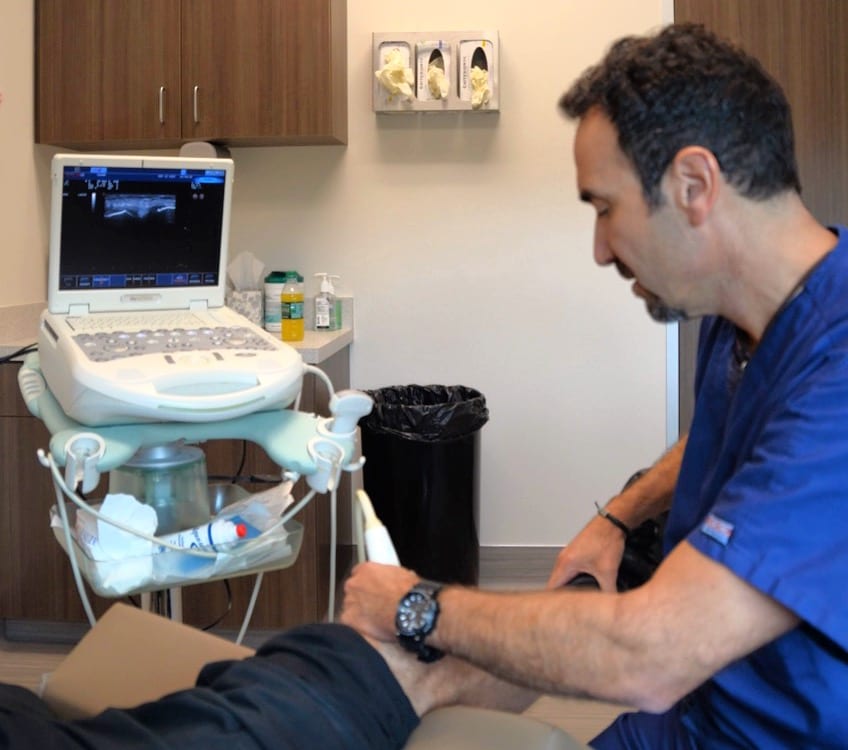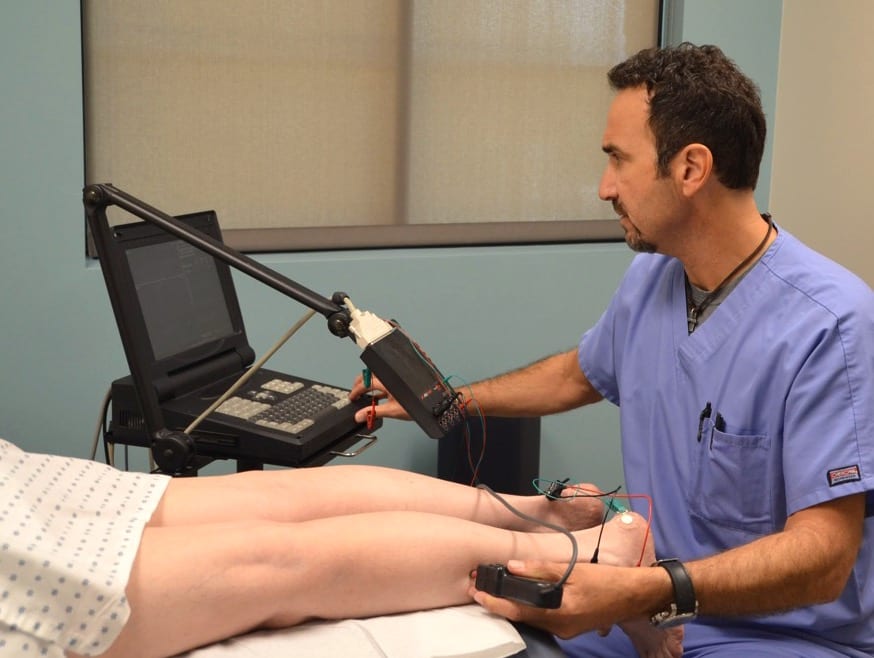I cannot stress enough the importance of using image guidance with injections. The above link is an unfortunate example of how a seemingly simple injection can result in devastating consequences that may have been avoided by using tools to improve safety and outcomes.
Injections into and around joints, nerves, ligaments and tendons can be done “blind” or with use of image guidance. Blind injections involves placement of a needle based on anatomical landmarks alone. The needle tip is assumed to be in the correct position with this technique, but strategy is very susceptible to error. To improve safety and accuracy of needle placement, physicians can use fluoroscopy, ultrasound or EMG for image guidance with injections.
Fluoroscopy involves the use of a mobile X-ray machine that shows bony landmarks with quick X-rays being taken in real-time. When the needle is thought to be in place, the physician will inject contrast (X-ray dye) to ensure the medicine is going to go exactly where it is intended.
Ultrasound is an excellent tool used to show live images of nerves, muscles, blood vessels and connective tissues along with the outside portions of bones. This allows for evaluation of these tissues with movement and in different positions.
We can also use an EMG machine (electromyography) to listen to muscle activity. EMG-guidance can be very useful when injecting spastic muscles.

Fluoroscopy at CHARM 
Ultrasound at CHARM 
EMG at CHARM
Advantages of using image guidance with injections:
Accuracy
Use of image guidance will help ensure precise placement at the target site.
Efficacy
Injection of medicine/injectate into the intended structure improves effectiveness of the procedure. This leads to increased…
Efficiency
Use of image guidance often makes the injection go smoother and quicker. This greatly decreases patient discomfort and anxiety along with decreasing the pain of injecting the wrong area/structure. We find that most of our patients are surprised at how easy and painless most injections can be. There is also less of a likelihood for repeat injections due to failure to reach the target with blind injections.
Safety
Injections have substantial risk. Use of image guidance will help minimize the risk of potentially catastrophic events that can be caused by inadvertent injection into nerves, blood vessels, tendons, ligaments or other structures that we are not actively targeting.
Why doesn’t everyone use image guidance with injections?
Lack of training
Many practitioners do not have the training background to understand how to use these complex machines when performing an injection. Even scarier, some practitioners have little to no injection training at all before they begin performing injections.
Lack of confidence
Use of image guidance can be an intimidating process, especially if the practitioner is not adequately trained to use the equipment and interpret the results.
Lack of resources
Fluoroscopes, ultrasound units and EMG machines are very expensive and take up a lot of space. May practices do not have the space and cannot/will not invest the money for a proper set up. This can be especially difficult for those that do not have a medical practice that is dedicated to performing injections.
Arrogance
Some practitioners view injections as quick and easy procedures that do not require significant consideration. Some feel they are excellent injectionists and always access the target site with their extraordinary skill and knowledge of anatomy. Study after study has refuted this. Almost every study that has compared blind with guided injections has found far greater accuracy with the use of guidance.
https://www.ajronline.org/doi/full/10.2214/AJR.17.19011
https://www.mjrheum.org/en_US/december-2016/showfulltext792/1/newsid792/57
https://www.sciencedirect.com/science/article/pii/S0049017213000668
https://pubmed.ncbi.nlm.nih.gov/24384272/
https://pubmed.ncbi.nlm.nih.gov/24477726/
It is especially dangerous to have this hubris when attempting to inject areas of high risk, like spinal nerves and the joints of the upper cervical spine. I cringe when I hear doctors giving lectures promoting the use of blind technique for such injections.
The practitioners at CHARM are experts at using various forms of guidance for injections, whether this is fluoroscopy, ultrasound or EMG. We have trained years to develop these abilities and continually update our skill sets through training courses, lectures and updated information from medical societies. We are able to utilize image guidance to safely and accurately access just about any joint, nerve, tendon and ligament in the body.
Injections have inherent risks associated with them. It is our responsibility to respect this fact and to minimize potential risks, while improving potential outcomes and maximizing patient comfort. Use of image guidance with injections is a critical skill set for optimization the effectiveness of injections. It is one of the many things that sets CHARM apart in your patient experience. https://charmaustin.com/why-charm/your-experience/

Board-Certified Physical Medicine & Rehabilitation by ABPMR and AOBPMR
Fellowship-Trained and Board-Certified in Pain and Musculoskeletal Medicine
